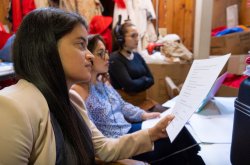American Council of the Blind Honors Students’ with 2019 Audio Description Achievement Award
Award recognizes groundbreaking live Spanish language audio description of Off-Broadway play
Posted in: Arts, University

While audio descriptions of on-screen images and action have long allowed visually impaired audiences to enjoy movies and television programs, they are seldom available to theatergoers in English – much less in Spanish.
This spring, nine Montclair State University students provided the first live Spanish audio description offered by an off -Broadway theater. The American Council of the Blind (ACB) has recognized their outstanding contribution to the development of audio description in the performing arts with a 2019 Audio Description Achievement Award.
The students, who were taking Spanish and Latino Studies Professor Mariá José García Vizcaíno’s Special Topics on Spanish Language: Audio Description class, had provided live Spanish language audio description during a New York City Repertorio Espãnol production of Nobel Prize laureate Gabriel García Márquez’s play, El coronel no tiene quien le escriba (No One Writes to the Colonel.)
This unique opportunity was the result of a partnership with the Repertorio Español. García Vizcaíno remembers introducing herself to Repertorio Español Artistic Director Rafael Sánchez and expressing her interest in involving her students in a theater project for the visually impaired New York and New Jersey Latino community. “He loved the idea and suggested the Márquez play because it is very visual and so would be ideal for audio description,” she says.
The student team scripted the audio descriptions of onstage action so it could be read live during the performances from backstage for a dozen visually impaired audience members who wore special headsets. A pre-show “tactile experience” had familiarized them with onstage objects.
“Graduate student Vanessa Carillo – who had two assistants in the booth to help her – was the voice talent who read the script during the entire run of the play,” says García Vizcaíno.
Colleen O’Rourke-Heredia took the course towards her MA in Spanish, Interpreting and Translation. “The greatest challenge for us as writers was to succinctly describe the visual action on the stage in a brief, creative manner in Spanish,” she says. “This required careful vocabulary choices and the need to work with the time challenge of only being able to use the silences during the breaks between the dialogues on stage. We only had mini sound bites of time to give clear, creative audio descriptions.”
For O’Rourke-Heredia, it was a memorable experience to be part of the groundbreaking team. “This was the first time a Spanish-spoken play was delivered live with live audio description in Spanish for a Spanish-speaking audience with visually impaired patrons,” she says. “It was an amazing experience and a challenging project to complete within one semester. Dr. García Vizcaíno’s leadership, training and commitment led to the project’s success.”
García Vizcaíno, who will be traveling to Rochester (New York) in July to receive the ACB award, was inspired by her legally blind sister to teach her course. “I was determined to teach Spanish-language audio description when I started listening to it with her on TV and in movie theaters in Spain,” she explains. Students in her class also produced a Spanish language audio description track for the short film, 17 años juntos, by Spanish filmmaker Javier Fesser.
While she will teach audio description again in the fall as part of a class she is offering in audiovisual translation, she also hopes to be able to repeat the live theater experience with another Repertorio Español play. “The most gratifying aspect for me was to see just how much the visually impaired people enjoyed the play, and the pre-show tactile experience,” says García Vizcaino.
O’Rourke-Heredia would also like to see a repeat performance. “We were nine deeply committed Montclair State students and we all worked hard together to make this project a success,” she says.
